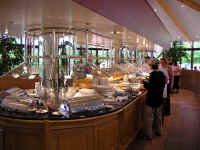 |
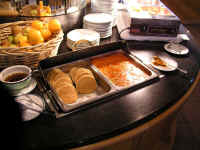 |
We thought you'd like to see the spread for a typical buffet breakfast at
some of the hotels. Very strange to the typical US visitor is the presence
of spaghetti (shown here next to pancakes) and even baked beans - for
breakfast?
This morning we visited the Agrodome (web site) where we were shown some of the many different breeds of sheep raised in New Zealand as well as a sheep shearing demonstration.
On our way to the Agridome our bus driver admonished us that there was thing not allowed in the building. He said not to say the words "mint jelly" as the sheep would get very nervous ... :-)
No, Joan, I know he's cute but you can't take him home ....
Some of the 19 breeds of sheep in New Zealand including the Merino (premium
wool producer), the black faced (mainly used in meat production) and Romney
(which was meat and wool). It was interesting to learn that the wool is so
different between breeds. One type of wool is so dense that it is used
mainly for wool carpeting.
The shearing demonstration. I think some of the girls were paying more attention to the guy than to the shearing demonstration. It was interesting in the way the Shearer got the sheep to relax so that he could shear it without danger of injuring the sheep. For example, there was a pressure point on the sheep's upper leg that caused the leg to straighten right out. The Shearer wears soft suede shoes so that he can use his toes to press the pressure points on the sheep's back, keeping the sheep relaxed. A top Shearer can do between 600 to 800 sheep in a day. Shearing is hot and sweaty work.
We saw 2 types of sheep dogs -- one used barking to herd the sheep and the other used eye contact alone. Amazingly, both dogs can run over the herd by walking on the backs of sheep.
We also saw a demonstration of 'dog trials' where the dogs are timed in their ability to herd sheep (in this case four) into a small pen. The handler is only allowed to communicate with the dog using different whistle sounds and hand signals.
Shown below is a 'carding machine'. It's used to pull and straighten the fibers of the wool in preparation for spinning it into yarn and thread. The machine was built in 1906 and they said that it runs as well today as it did when it was first built.
This machine puts on demonstrations (we saw it run) as well as being used to card wool for the local spinners guild to raise money for the museum.
The wool is loaded into the right-hand end (last photo) and comes out the left-hand end (2nd photo). The large drums do most of the work and are covered with thousands of wire 'hairs' sticking up from the drum.
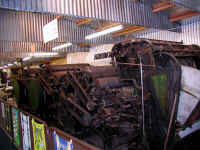 |
 |
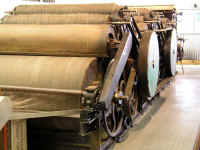 |
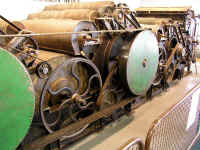 |
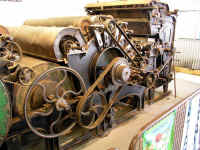 |
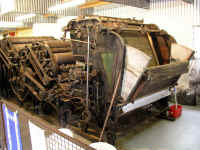 |
We had lunch in Tirau. The main street had many arts and craft shops as well as antique stores. We had about an hour to investigate the shops.
The information center was very proud of the area's sheep industry :-)
We went to visit Dave Watt's shop. Dave is an accomplished local model engineer who is a ship's engineer during his working hours. Dave has built several locomotives, stationary engines, etc.
He has a well equipped shop to work in - and neat too (well, he did admit that, knowing that we were coming, he had cleaned up a bit). The wives think that their husbands shops should look as neat as this one.
Here are some views of copper boiler parts and some other locomotive parts Dave is currently working on - talk about neat ...
A couple of locomotives Dave has built or rebuilt:
This is the setup that Dave uses to heat copper boilers for silver brazing.
Talk about neat and well organized! This is Dave's metal rack and
'scrap' bins. I photographed it to serve as inspiration for organizing my
shop!
We checked into our hotel in Hamilton and then went to the track to register for the "Steam and Steel 2004" the New Zealand International Convention of Model Engineers which was a three-day event held (this year) at the Hamilton Model Engineers society grounds.
The women of the Hamilton club provided a delicious evening bar-b-que with sausage, meat patties, and homemade salads. Hockey-Pockey ice-cream (somewhat like our butter-brickle) is now our favorite dessert. Doug (another tour member) and I volunteered to scoop ice cream and fruit salad.
These were interesting geological structures. We thought that they were
just small hillocks but David, our bus driver, told us that these are bulges of
rock thrust up by volcanic activity.
Our hotel room in Hamilton ...
Next day: January 9th